Birth Control
![]()
Introduction
The term birth control refers to various techniques which are used to prevent a woman from becoming pregnant. Other terms used to describe birth control methods are contraception and family planning.
Some methods of preventing pregnancy include medical procedures, some involve taking pills, some require the use of certain devices while others only require a particular lifestyle. In a few of the examples below, photographs show what is necessary for that particular method to work.
Top Ten Methods of Birth Control
1. Abstinence
Abstinence means not having sexual contact with others. People usually choose such a method for religious or personal reasons. It is the only method 100% sure for not getting pregnant or not getting sexually transmitted diseases.
2. The Condom
The condom is a tube of latex (synthetic rubber) placed over the man's erect penis before penetration of any kind. Condoms can be bought without seeing a doctor; no prescription is necessary. Not only do they prevent pregnancy, but they are also a good protection for both partners against the spread of bacteria or the transmission of viruses such as HIV. But the condom is only effective when used correctly. Unfortunately, many people have become pregnant or contracted a disease because they did not use the proper techniques. Click here to see the rules of how to use a condom correctly.


3. The Pill
The pill, more scientifically known as oral contraception, must be taken by the woman every day. It stops ovulation. The woman must have a doctor's prescription in order to buy it in a pharmacy. As with any medication, there are sometimes side effects.
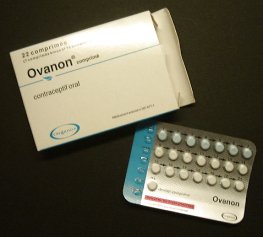
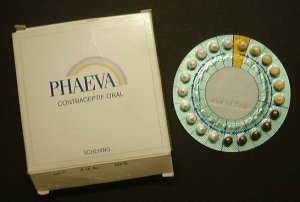
4. Vasectomy or Sterilization
A vasectomy is an operation done on a man who does not want to have children or any more children. Both of his sperm tubes are cut and tied. He can still have a normal sex life and he will still ejaculate. The only difference is that his semen will only contain the fluids from the seminal vesicles and the prostate gland - there will be no sperm cells present.
Sterilization is when a woman's oviducts (also called Fallopian tubes) are cut and tied during surgery. She will continue her menstrual cycle and she can still have a normal sex life, the only difference is that there will never be any eggs present in the oviducts.
In both cases, the cells which are "trapped" (egg cells or sperm cells) and not used will be broken down by the body and reabsorbed. Both of these operations are not reversible, so the man or the woman must be sure that they do not want children.
5. The Intrauterine Device or IUD
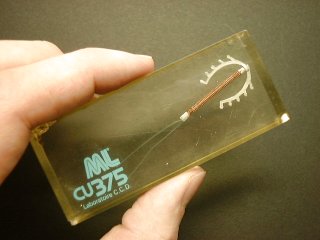 The IUD is
a coil of metal and / or plastic which is placed in the uterus by a
doctor. It lasts several years. Notice the threads which allow
the doctor to recover the IUD when it is time to take it out.
The IUD is
a coil of metal and / or plastic which is placed in the uterus by a
doctor. It lasts several years. Notice the threads which allow
the doctor to recover the IUD when it is time to take it out.
The IUD works by preventing implantation.
(Note: The one shown in the photograph is encased in transparent plastic as a demonstration.)
6. Coitus Interruptus
This method involves pulling the penis out of the vagina just before ejaculation. The term coitus interruptus comes from Latin meaning to interrupt sexual intercourse (coitus). Although it is true that this method insures that most sperm cells do not get into the vagina, some can still pass for the simple reason that a man secretes liquids out of the penis before ejaculation. Such liquids are intended to lubricate the penis but they can contain hundreds of sperm cells. Also, this method relies on the man pulling his penis out in time, which is not always easy to control.
7. Contraceptive Creams and Foams
These are used to make other methods, such as the condom or the diaphragm (see below), more effective. They are are not very effective when used alone. They are placed in the vagina or around the diaphragm and they contain spermicides (chemicals to kill sperm cells). They can be bought in a pharmacy without a prescription.

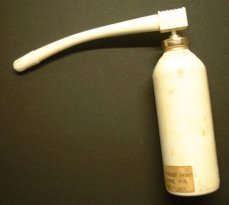
8. The Diaphragm or Cap
This is a wide flexible latex dome which is placed at the top of the vagina. It blocks the opening of the uterus. A woman must see her doctor to get a prescription for one which is the correct size, but once she buys it, she can put it in and take it out by herself when necessary. It is reusable but it is important that it is kept clean and that it does not get damaged. Like the condom, the diaphragm is only good at stopping sperm cells if used correctly. Its effectiveness is increased by using spermicides.
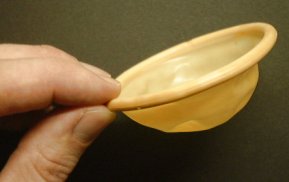
9. The Rhythm Method and The Basal Temperature Method
Because a woman's menstrual cycle is relatively predictable (menstruation about every 28 days), she can estimate when an egg will be present in her oviducts. Usually, an egg is produced 14 days after her last menstruation. She can use abstinence during the days when she thinks an egg might be present.
This method does not always work for the simple reason that a woman's menstrual cycle can change from month to month making it difficult to be sure when an egg is present. Also, after sexual intercourse the man's sperm cells can stay alive for several days inside her reproductive system. If an egg is produced during those days, she can become pregnant.
Similar to the rhythm method, the basal temperature method does not require any special devices or chemicals, only a thermometer to measure body temperature. If a woman measures her temperature every day just as she is getting out of bed in the morning, she will notice that in the middle of her menstrual cycle, her body temperature will increase by about half a degree Celsius. This is a sign that she is ovulating. If she keeps a good record of her body temperature, she can predict when she will be producing an egg. If she practices abstinence around the time when the egg will be present, she will avoid getting pregnant.
For the same reasons as the rhythm method above, this method does not always work. In addition, if the woman has a slight fever, she might misinterpret the increase in her body temperature as a sign of ovulation.
10. The Morning After Pill
This is a pill which a woman can take within the first 72 hours (3 days) after sexual intercourse. It contains strong doses of chemicals which provoke menstruation. With the lining of the uterus gone, no embryo could possibly survive. The side effects are often very uncomfortable (abdominal pain, vomiting). This method should only be used in emergencies.
| Important note: Notice that this list does not contain any techniques which terminate the pregnancy after implantation. Such techniques are not considered birth control and should not be used as such. Birth control should be preventive. It should act before the woman becomes pregnant - in other words, before implantation of the embryo into the lining of her uterus. |
How can a woman find out if she is pregnant? The
first sign is that she stops her menstrual cycle. This is not
a 100% sure sign of pregnancy, though, because cycles can be
unpredictable and can stop for several other reasons.
Ultrasound technology only works when the baby is big enough to be
seen on the video screen. A more reliable test can be bought
in a pharmacy. It tests for hormones present in a woman's
urine and gives the result as a color change:
This is usually quite reliable but the only way to be 100% sure is to get a blood test. |


© A.W. Damon 2003
Last modification: 2003-01-09

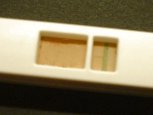 (-) not pregnant
(-) not pregnant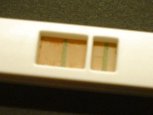 (+) pregnant
(+) pregnant